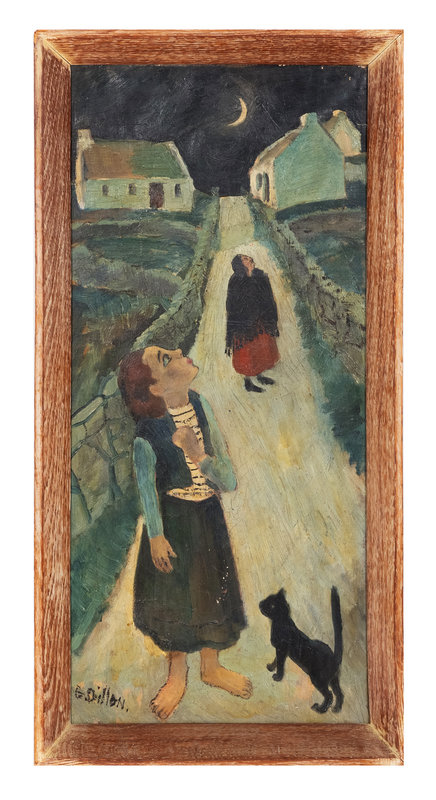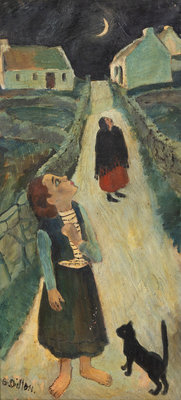Condition Report
Contact Information
Auction Specialist
Lot 55
Lot Description
We are grateful to Karen Reihill for her kind assistance with the cataloguing of the present lot.
Exhibited:
New York, Associated American Artists Galleries, Contemporary Irish Paintings, March 3 - 22, 1947, no. 59, illustrated on the cover (also traveled to Chicago, Ottawa, and Beverly Hills, California)
Literature:
James White, Gerard Dillon: An Illustrated Biography, Dublin, 1994, p. 54
Karen Reihill, George Campbell and the Belfast Boys, Dublin, 2015, p. 44 (Associated American Artists Galleries exhibition cover illustrated)
Karen Reihill, O'Neill: Romanticism and Friendships, Dublin, 2020, p. 192 (Associated American Artists Galleries exhibition cover illustrated)
Lot note:
Whatever you have in your hand when you see the new moon first; you will have plenty of that before the next new moon comes.
Turn Your Money by Gerard Dillon is a visual amalgamation of Irish folk tales and myths. The present artwork depicts two women who stand in a country lane and gaze upward at the crescent moon in an inky black sky. The lane is lined on each side with traditional stone walls and at its end stand three white-washed cottages. The younger of the two women, with a black cat by her bare feet, clutches her left hand to her chest. The title, Turn Your Money, refers to an Irish country tradition that with the coming of the new moon, people would pray for health, wealth, and good fortune. It was also thought to be bad luck to see the new moon first through glass, so people would ensure that they stepped outside to view the planetary object in its beginning phase and not accidentally see it through a window. The black cat is another reference to an Irish folktale of the black bog cat, a mysterious creature who is said to have prowled around the shores of Lough Neagh, a lake in Northern Ireland. Cunning, swift, and unusually large, this mythical cat is rumored to bring great wealth and happiness to those lucky enough to run into it.
Born in the industrial city of Belfast, Dillon was fascinated with Ireland's mythical rural life and often portrayed locals in their everyday existence in Donegal, the Boyne Valley, and the west of Ireland in the 1940s and 50s. This region, so far from the strife and conflict of Belfast, was to be important to the development of his career. Dillon was a mostly self-taught artist, and his discovery of the Irish countryside during a cycling trip with a friend in the summer of 1939 was a revelation in terms of his subject matter. He saw in the area and the people a freshness and simplicity, as “visual symbols of the country he had dimly dreamt of and idyllically desired to belong to” (James White, Gerard Dillon, An Illustrated Biography, Dublin, 1994, p. 34). The artist valued openness and honesty and he consciously adopted a primitive style, once declaring he wanted to paint with “a child’s directness” (J. White, ibid., p. 59). Using thick impasto and broad brushstrokes, along with simple outlines and bold color contrasts, his depictions of Western Ireland ignore perspective and realism to chronicle a way of life that had been virtually unaffected by World War II.
During the war, Dillon settled in Dublin, as southern Ireland remained neutral. He became part of a thriving artistic community, which included Irish artists such as Louis le Brocquy, Patrick Hennessy, and Daniel O’Neill. It was as part of this group that Dillon participated in a 1946 exhibition with other Irish artists at the Leicester Gallery in London. The success of this exhibition led to this group of painters to be invited to show at the Associated American Artists’ Galleries in New York. The exhibition, Contemporary Irish Paintings, opened on March 3, 1947, and included Jack Butler Yeats, Colin Middleton, Nano Reid, Norah McGuinness, George Campbell, Le Brocquy, and Dillon. Turn Your Money was the cover illustration for the exhibition catalogue. Dr. Theodore Goodman, art critic for the Irish monthly magazine, Commentary, wrote in a review that “the subject matter is typically Hibernian in its poetic often mystic quality. One example of this is Gerard Dillon’s Turn Your Money which shows two women looking at the new moon over their left shoulders. It is done in somber, quiet tones...” (J. White, ibid., p. 54).
Through its strong sense of narrative, the present painting evokes the traditional beliefs of rural Ireland. The impression of innocence is further emphasized by the artist’s deliberately naïve execution, with its bold lines that delineate the women’s faces, the rocks in the walls, and the traditional cottages. Perspective is modified at will by Dillon, with the wall behind the young woman seeming to lean backward with her body as she gazes at the moon, yet the road on which the two figures stand leads into the darkness through the use of traditional perspective. A moody and mysterious scene, Turn Your Money chronicles the artist’s admiration of the captivating simplicity of western Ireland.









